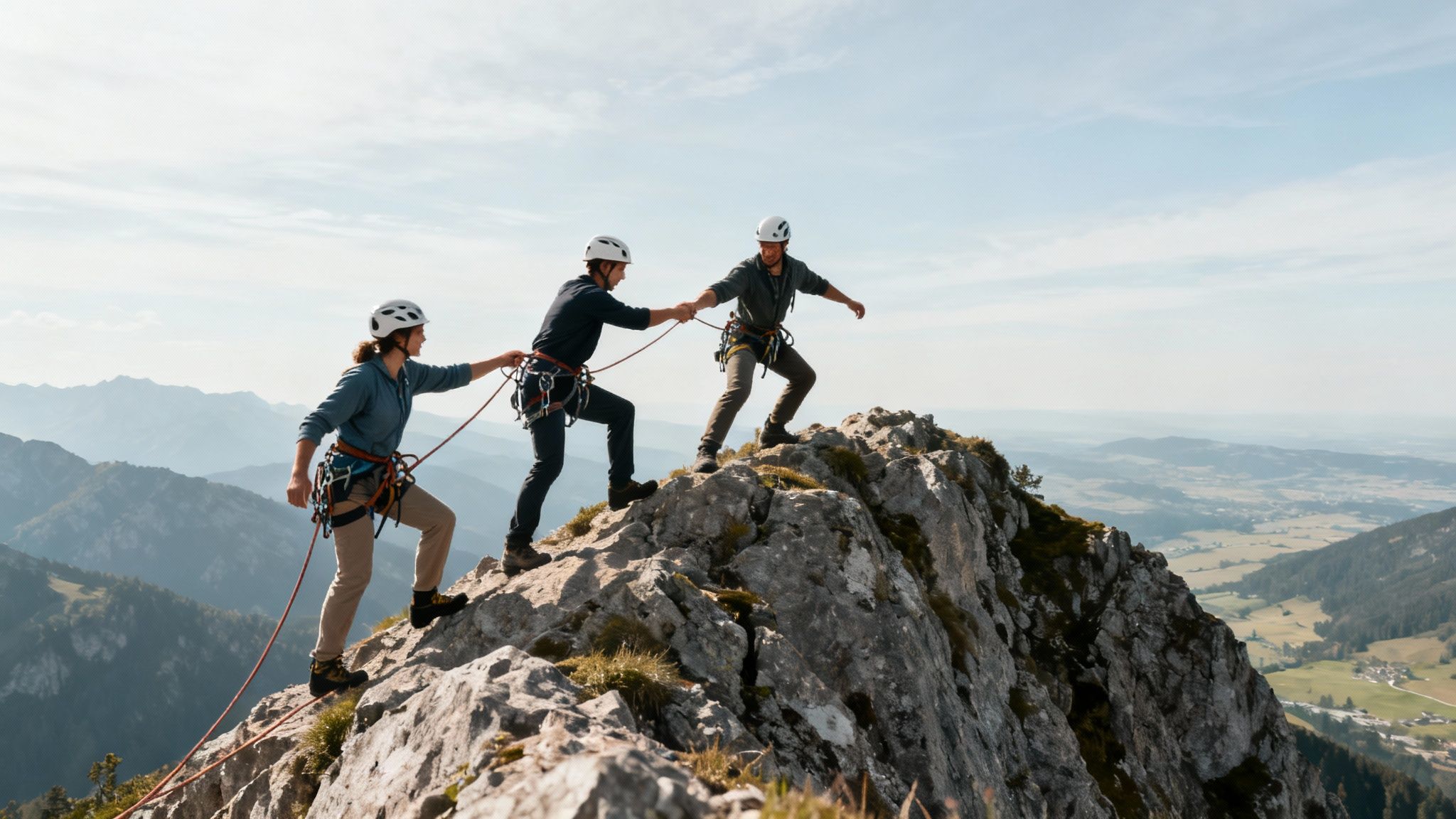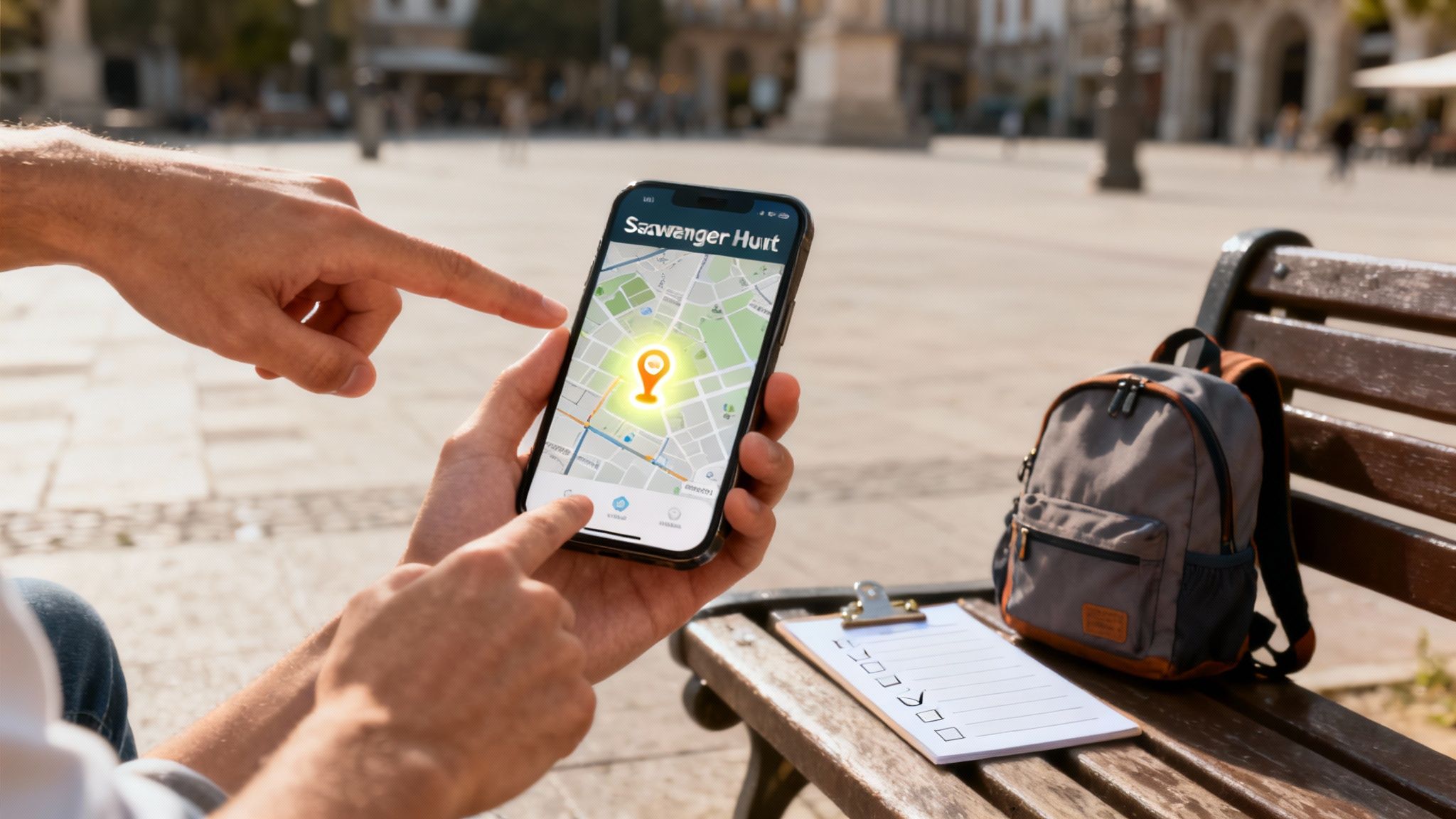Blog

Top team bonding events for a strong culture in 2025
By BeThere
Oct 25, 2025 • 21 min read

In today's fast-paced, often-remote work environment, fostering genuine connections among team members is more critical than ever. Strong teams don't just happen; they are built through shared experiences that go beyond daily tasks and video calls. Effective team bonding events are the cornerstone of a vibrant company culture, leading to improved communication, higher morale, and increased productivity. But organizing these events, especially for hybrid teams, can be a logistical nightmare of juggling schedules, sending endless reminders, and managing RSVPs across different platforms.
This guide moves beyond generic advice to provide 10 diverse and impactful ideas for team bonding events, from outdoor adventures to creative workshops, designed to strengthen your team's fabric. We will detail actionable steps for each, whether your team is in-person, fully remote, or a hybrid of both. You will learn not just what to do, but how to do it effectively. While structured events are crucial, remember that daily interactions also build camaraderie. Exploring the benefits of a strong office coffee culture shows how small, consistent efforts can complement larger initiatives.
Most importantly, we'll show you how to streamline the entire planning process from start to finish. For companies that rely heavily on Slack and Google Calendar, coordinating these activities can become surprisingly simple. With the right approach, you can create memorable events without the administrative headache.
1. Outdoor Adventure Activities
Outdoor adventure activities are structured experiences that challenge teams in natural settings. Events like hiking, rock climbing, or white-water rafting push participants out of their comfort zones, requiring strong communication, trust, and collaboration to succeed. By tackling physical and mental obstacles together, teams build resilience and develop deeper bonds away from the office environment.

These events are powerful because they create shared memories and a sense of collective achievement. For example, Google is known for its rock climbing outings in Colorado, while Deloitte hosts annual hiking challenges to boost team morale. Such team bonding events break down hierarchies and encourage authentic interaction.
✦How to Organize Outdoor Adventures
Planning a successful outdoor event involves careful consideration of logistics and safety.
- Assess Fitness Levels: Survey your team to understand their physical abilities and comfort with different activities. This ensures the chosen event is inclusive and enjoyable for everyone.
- Hire Certified Guides: For activities like rafting or climbing, always use professional, certified instructors to guarantee safety and proper guidance.
- Coordinate with BeThere: If your company runs on Slack and Google Calendar, a tool like Be There is incredibly handy. You can create the event in Slack, and it automatically syncs with everyone’s Google Calendar, gathers RSVPs, and sends reminders without ever leaving your workspace. It eliminates the need to switch between apps, making coordination seamless.
- Plan for Safety: Ensure you have comprehensive liability insurance, a first-aid kit, and clear emergency protocols.
For more inspiration, check out these unique company outing ideas.
2. Escape Room Challenges
Escape room challenges lock teams in a themed room where they must solve a series of puzzles and find clues to "escape" within a time limit, usually 60 minutes. This high-pressure environment demands sharp problem-solving, effective communication, and collaborative strategic thinking, making it an excellent team bonding event for fostering synergy and identifying natural leaders.

These events are highly effective because they place everyone on an equal footing, requiring diverse skills to succeed. For example, Uber uses escape rooms to integrate new hires, and Microsoft has even created branded experiences for internal teams. The shared sense of urgency and collective "aha!" moments create strong, memorable bonds that translate back to the workplace.
✦How to Organize an Escape Room Challenge
A successful escape room outing depends on thoughtful planning and clear communication.
- Select the Right Theme and Difficulty: Choose a theme that will engage your team and a difficulty level that is challenging but not impossible. Consider your team’s experience with puzzles to ensure it's fun for everyone.
- Mix Up the Teams: Deliberately create groups with members from different departments or teams. This encourages cross-functional collaboration and helps break down organizational silos.
- Streamline Coordination with BeThere: Organizing the outing is simple with a tool like Be There, especially for companies that use Slack and Google Calendar. You can create the event directly in Slack, poll team members on their preferred theme, and automatically sync all details to their Google Calendars. It keeps RSVPs and event information in one place, avoiding confusion.
- Hold a Debrief Session: After the game, facilitate a brief discussion about what strategies worked, how the team communicated, and what they learned. This turns a fun activity into a valuable learning experience.
3. Team Sports Tournaments
Team sports tournaments are organized competitive events where employees form teams to compete in activities like soccer, basketball, bowling, or volleyball. These events harness the power of friendly competition to build camaraderie, promote physical wellness, and boost team spirit. By working together towards a common goal on the field or in the alley, colleagues develop communication skills and a strong sense of unity.
These team bonding events are effective because they create a fun, high-energy environment outside of typical work responsibilities. For instance, Amazon hosts its annual customer service Olympic games, while Goldman Sachs organizes employee sports leagues to foster teamwork and engagement. Such activities allow team members to connect on a more personal level.
✦How to Organize Team Sports Tournaments
A successful tournament requires planning to ensure it's fair, fun, and safe for everyone involved.
- Create Balanced Teams: Mix departments and skill levels when creating teams. This encourages cross-functional collaboration and prevents any single team from being unfairly dominant.
- Emphasize Participation: Focus on the spirit of the game rather than just winning. Offer small prizes for participation, sportsmanship, or "most improved" to make everyone feel included and valued.
- Streamline with BeThere: Managing sign-ups and schedules can be complex. For teams already using Slack and Google Calendar, Be There is the perfect solution. Create the tournament event in Slack, and it automatically syncs with everyone's calendar and makes gathering RSVPs effortless, so you can focus on the fun instead of logistics.
- Prioritize Safety: Ensure qualified first-aid personnel are on-site. Schedule proper warm-up and cool-down periods, and have alternative, less-strenuous activities for those who cannot participate in the main sport.
For a different kind of competitive fun, consider these virtual game ideas for remote teams.
4. Volunteer Community Service Projects
Volunteer community service projects unite teams around a shared purpose beyond business goals. By collaborating on meaningful activities like working at a food bank, participating in habitat restoration, or mentoring youth, colleagues build connections while making a positive impact. These shared experiences foster empathy, teamwork, and a sense of collective pride that translates back to the workplace.
This approach to team bonding events is powerful because it aligns corporate values with employee action. For instance, Salesforce champions its 1-1-1 model, encouraging employees to volunteer, while Microsoft mobilizes over 50,000 employees for its annual community service week. These initiatives demonstrate a commitment to social responsibility and strengthen organizational culture.
✦How to Organize Volunteer Projects
Coordinating a successful volunteer day requires thoughtful planning and clear communication.
- Partner with Nonprofits: Collaborate with reputable local charities or non-governmental organizations. They can provide structured opportunities, guidance, and context for your team's contribution.
- Align with Employee Interests: Survey your team to find causes they are passionate about. Aligning the project with their interests boosts engagement and makes the experience more meaningful.
- Simplify Coordination with BeThere: Use Be There to manage all logistics directly within Slack. This is extremely useful for companies that live in Slack and Google Calendar. You can create the event, poll team members on their preferred charity, and send reminders without juggling multiple platforms. RSVPs are collected in Slack and events are synced to Google Calendar automatically.
- Provide Clear Orientation: Work with the partner organization to ensure all participants receive proper orientation and safety training before the event begins.
5. Creative Workshop Sessions
Creative workshop sessions are guided, interactive events where teams participate in hands-on activities like pottery, cooking classes, or music jams. These sessions encourage team members to step outside their usual job functions, fostering creativity, innovation, and a different kind of collaboration. By focusing on a shared, tangible goal, colleagues can connect on a more personal level.
These team bonding events are effective because they create a relaxed, judgment-free zone where fun is the priority. For instance, Airbnb is known for its team pottery painting sessions, while HubSpot often organizes art workshops to spark creative thinking. Such activities allow team members to see new sides of each other, building stronger, more authentic relationships.
✦How to Organize Creative Workshops
A successful creative workshop depends on a supportive environment and clear logistics.
- Choose an Inclusive Activity: Select a workshop that is beginner-friendly and appeals to a wide range of interests. The goal is participation, not perfection.
- Hire an Engaging Instructor: A skilled facilitator is key. They should be able to guide the group, encourage interaction, and make the experience enjoyable for everyone, regardless of skill level.
- Streamline with BeThere: Coordinating a workshop is simple with the right tools. Use Be There to create the event directly in Slack. It’s a handy tool for teams using Google Calendar, as it will automatically send invites and collect RSVPs, keeping all your planning consolidated and efficient within the tools you already use.
- Focus on the Experience: Emphasize that the workshop is about the process, not the final product. Encourage team members to experiment and have fun, and let them take their creations home as a memento of the event.
For more ideas on engaging your team, explore these virtual team building activities.
6. Team Retreat & Offsite Events
Team retreats and offsite events are multi-day, immersive experiences that remove teams from their usual work environment. Held at resorts or dedicated retreat centers, they combine strategic planning sessions, team building activities, and relaxation to foster deep connections. By stepping away from daily distractions, teams can focus entirely on collaboration, innovation, and strengthening relationships in a focused setting.
These extended team bonding events are powerful because they create a unique, shared experience that accelerates trust and alignment. For example, Patagonia holds multi-day employee retreats focused on reinforcing its culture, while Netflix is known for its quarterly team offsites at inspiring destinations. This dedicated time together helps break down silos and encourages open, strategic conversations.
✦How to Organize Team Retreats & Offsites
A successful retreat requires meticulous planning to balance work, fun, and rest.
- Balance the Itinerary: Create a detailed schedule that mixes structured work sessions with optional activities and downtime. This ensures participants feel productive without getting burned out.
- Communicate Clearly: Provide all essential information well in advance, including the agenda, packing list, costs covered by the company, and expectations for participation.
- Simplify Coordination with BeThere: Managing a multi-day event can be complex. For companies that coordinate through Slack and Google Calendar, Be There is a lifesaver. Create the main event in Slack, and it automatically syncs with everyone’s calendar. You can also send updates, track RSVPs for different sessions, and share the itinerary all within Slack.
- Include All Logistics: Arrange transportation, accommodate all dietary needs, and secure comprehensive travel insurance to ensure a seamless and safe experience for everyone.
For those looking to host an unforgettable offsite, explore these 10 inspiring team building retreat locations.
7. Hybrid Scavenger Hunts & Challenges
Hybrid scavenger hunts combine physical and digital elements into a modern team competition. Teams work together to solve riddles, complete location-based challenges, and collect items within a set timeframe. This format is incredibly versatile, accommodating in-person, virtual, or hybrid teams, making it one of the most inclusive team bonding events available.

These events are effective because they promote problem-solving, strategic thinking, and friendly competition. For instance, Salesforce uses app-based challenges to connect its global teams, while Google organizes neighborhood scavenger hunts to encourage local exploration. These activities create a dynamic and memorable shared experience that boosts morale and strengthens relationships.
✦How to Organize a Hybrid Scavenger Hunt
A successful scavenger hunt requires clear rules and seamless technology.
- Create Accessible Challenges: Design a mix of tasks that cater to different skills and physical ability levels. Include digital puzzles for remote members and physical tasks for those in the office.
- Test All Technology: Thoroughly test any apps, QR codes, or communication platforms before the event starts. Have a paper-based backup plan ready in case of technical issues.
- Simplify Coordination with BeThere: Be There is particularly useful here, as it lives where your team works: Slack. Organize the event, share rules, team assignments, and start times, and it will automatically sync with everyone’s Google Calendar. This keeps all communication and logistics in one central hub for both remote and in-office staff.
- Offer Motivating Prizes: Choose rewards that encourage participation, like gift cards, extra time off, or a team lunch. Document the event with photos to share afterward and celebrate the winning team.
8. Professional Development & Skill-Sharing Workshops
Professional development and skill-sharing workshops are structured learning sessions where team members teach each other valuable skills. These events can cover anything from public speaking and leadership to technical coding or wellness practices. By creating an environment of mutual learning and knowledge exchange, these team bonding events empower employees and build respect among peers.
This approach positions team members as experts, fostering a culture of continuous improvement and collaboration. Companies like Google and LinkedIn are well-known for their internal speaker series and employee-led learning sessions, which not only enhance skills but also strengthen internal networks. When colleagues learn from one another, it breaks down silos and encourages cross-functional appreciation.
✦How to Organize Skill-Sharing Workshops
A successful workshop requires thoughtful planning to maximize engagement and learning.
- Survey Interests: Ask your team what skills they want to learn and what expertise they are willing to share. This ensures the topics are relevant and exciting for everyone involved.
- Mix Expert and Peer-Led Sessions: Balance workshops led by external experts with sessions facilitated by internal team members to provide diverse perspectives and recognize in-house talent.
- Simplify Scheduling with BeThere: Announce the workshop schedule directly in a Slack channel. For companies that use Slack for communication and Google Calendar for scheduling, Be There bridges the gap perfectly. It automatically creates the calendar event, sends invites, and tracks RSVPs, all without leaving Slack. This is perfect for managing multiple sessions and ensuring everyone stays informed.
- Provide Resources: Offer materials for continued learning after the session, such as recordings, presentation slides, or a dedicated Slack channel for follow-up discussions.
For a deeper dive, explore our guide on planning an impactful team-building workshop.
9. Team Trivia & Game Night Events
Team trivia and game nights are competitions where colleagues form teams to test their knowledge or strategic skills. These events can range from classic pub-style trivia and board game tournaments to modern video game contests, creating a fun, low-pressure environment for friendly rivalry. By working together on challenges unrelated to their daily tasks, team members can interact in new ways and build stronger personal connections.
These team bonding events are effective because they tap into a natural sense of competition and collaboration. For instance, HubSpot hosts monthly team trivia, while Spotify organizes internal esports tournaments to engage its workforce. These activities boost morale, encourage strategic thinking, and allow different personalities to shine in a relaxed setting.
✦How to Organize Team Trivia & Game Nights
A well-planned game night ensures maximum engagement and fun for everyone involved.
- Mix Up the Teams: Create balanced teams by mixing departments and skill sets. This encourages cross-functional collaboration and helps colleagues get to know people outside their immediate circle.
- Use Digital Tools: Leverage platforms like Kahoot! or Sporcle for seamless scoring and question management, especially for trivia. This keeps the pace brisk and the energy high.
- Coordinate with BeThere: Use Be There to manage all the logistics directly in Slack, the hub of your team's communication. It will automatically create a Google Calendar invite and track RSVPs, making it effortless for your team to join the fun. This simple workflow is a huge time-saver.
- Offer Fun Prizes: Motivate participants with small, creative prizes for winning teams and even for participation. The goal is to celebrate the fun of taking part together.
10. Wellness Retreats & Group Fitness Classes
Wellness retreats and group fitness classes are team bonding events focused on promoting physical and mental health. Activities like group yoga, meditation workshops, or healthy cooking seminars provide a refreshing break from daily work pressures. They encourage team members to prioritize their well-being while building camaraderie around shared wellness goals in a supportive environment.
These events demonstrate a company's commitment to employee health, which can significantly boost morale and reduce burnout. For instance, Salesforce is known for its wellness retreat weeks, while Google offers free yoga and meditation classes to its teams. Investing in wellness shows employees they are valued beyond their professional contributions, fostering a healthier, more connected workplace.
✦How to Organize Wellness Events
A successful wellness event is inclusive, well-planned, and respectful of individual comfort levels.
- Offer Variety: Provide a range of activities to cater to different interests and fitness levels, from high-intensity fitness classes to gentle stretching or meditation sessions.
- Partner with Professionals: Hire certified instructors for yoga, fitness, or meditation to ensure a safe, high-quality, and professional experience for everyone involved.
- Simplify Coordination with BeThere: Use Be There to manage all the logistics directly within Slack. For companies reliant on Google Calendar, this integration is key. You can send out invites, collect RSVPs, and automatically sync the event, making it effortless to organize recurring classes or one-off retreats.
- Ensure Comfort and Privacy: Create a welcoming and non-judgmental atmosphere. Provide necessary facilities like changing areas and ensure all activities respect personal privacy.
For more ideas, explore these successful workplace wellness program examples.
Team Bonding Events: 10-Item Comparison
| Activity | 🔄 Implementation complexity | ⚡ Resource requirements | ⭐ Expected outcomes | 📊 Ideal use cases | 💡 Key advantages |
|---|---|---|---|---|---|
| Outdoor Adventure Activities | High — logistics, permits, safety planning | High — gear, guides, transport; $500–$3,000 | ⭐⭐⭐⭐ — trust, resilience, wellbeing | Offsite bonding, high-engagement teams, experiential retreats | Builds trust quickly; memorable shared challenges |
| Escape Room Challenges | Medium — venue booking, difficulty tuning | Low–Medium — venue fees; $150–$400 | ⭐⭐⭐ — problem-solving, communication | Short team sessions, onboarding, mixed-size groups | Reveals collaboration styles; quick, indoor option |
| Team Sports Tournaments | Medium — scheduling, referees, rules | Medium — facility rental, equipment; $200–$1,500 | ⭐⭐⭐ — team spirit, fitness | Recurring wellness programs, large-group events | Encourages healthy competition; scalable formats |
| Volunteer Community Service Projects | Low–Medium — partner coordination, training | Low — often sponsored; $0–$500 | ⭐⭐⭐⭐ — purpose, engagement, community impact | CSR initiatives, flexible half/full-day events | Strengthens purpose and employer brand; inclusive |
| Creative Workshop Sessions | Low — single-session planning, instructor booking | Low–Medium — materials, instructor; $300–$1,000 | ⭐⭐⭐ — creativity, low-pressure bonding | Small teams, social downtime, creative outlets | Tangible takeaways; encourages non-work expression |
| Team Retreat & Offsite Events | High — travel, multi-day logistics, itineraries | Very High — venue, travel, accommodations; $1,500–$5,000+ | ⭐⭐⭐⭐ — deep bonding, strategic alignment | Leadership retreats, strategy sessions, culture building | Immersive results; combines work and relaxation |
| Hybrid Scavenger Hunts & Challenges | Medium — tech setup, challenge design | Medium — app/dev and coordination; $400–$1,200 | ⭐⭐⭐ — engagement, gamified teamwork | Hybrid/remote-friendly events, urban exploration | Highly customizable; engaging for diverse teams |
| Professional Development & Skill-Sharing Workshops | Low–Medium — curriculum and facilitator prep | Low–Medium — expert fees, materials; $200–$1,000 | ⭐⭐⭐⭐ — skill growth, retention, mentorship | Ongoing learning programs, knowledge transfer sessions | Adds professional value; showcases internal talent |
| Team Trivia & Game Night Events | Low — host and materials setup | Low — minimal equipment; $200–$600 | ⭐⭐ — casual bonding, social energy | Evening socials, low-cost engagement, inclusive groups | Easy to organize; breaks down hierarchies |
| Wellness Retreats & Group Fitness Classes | Medium — instructor booking, venue for retreats | Medium — certified instructors, space; $300–$1,500 | ⭐⭐⭐⭐ — stress reduction, wellbeing, morale | Employee wellness programs, recurring classes, retreats | Supports long-term wellbeing; inclusive options |
Make Planning Your Next Event Effortless
Choosing the perfect team bonding event from the diverse options we've explored is an exciting first step. Whether you're planning an adrenaline-pumping outdoor adventure, a collaborative escape room challenge, or a relaxing wellness retreat, the goal remains the same: to strengthen connections, boost morale, and build a more cohesive team. The ideas in this guide, from volunteer projects to creative workshops, offer a robust toolkit for any leader looking to foster a positive and engaged work environment.
However, the true success of any of these fantastic team bonding events hinges on execution. A great idea can easily be derailed by cumbersome planning, disorganized communication, and low participation. The administrative burden of coordinating schedules, sending reminders, and tracking responses can quickly turn an inspiring initiative into a logistical headache.
✦From Idea to Execution: Bridging the Gap
The most critical takeaway is that the planning process should be as seamless as the event itself. For modern companies operating within Slack and Google Calendar, juggling multiple platforms to organize an event is inefficient and frustrating. Manual calendar invites get lost, RSVP tracking in spreadsheets is tedious, and last-minute reminders sent via email are often ignored. This friction not only drains the organizer's energy but also creates barriers to participation for the team.
This is precisely where integrating your event management into your existing workflow becomes a game-changer. Imagine announcing a Team Trivia Night or a Hybrid Scavenger Hunt directly in your main Slack channel, where your team is already active.
The key to maximizing engagement is minimizing friction. By making it incredibly easy for employees to see, RSVP to, and get reminders about an event within the tools they already use—like Slack and Google Calendar—you dramatically increase the likelihood of their participation.
✦The Power of Streamlined Event Management
A streamlined approach transforms event planning from a chore into a simple, effective part of your company culture. When event details are automatically synced to everyone's Google Calendar and reminders are sent through the communication tool they use all day, you ensure your event stays top-of-mind. This level of integration is incredibly handy and empowers you to focus on the high-value aspects of team building, like personalizing the experience and engaging with your colleagues, rather than getting bogged down in administrative tasks.
Ultimately, investing in effective team bonding events is an investment in your company's most valuable asset: its people. By making these gatherings effortless to organize and attend, you create a sustainable cycle of positive engagement. You’re not just planning a one-off activity; you’re building a foundational element of a vibrant, connected, and thriving workplace culture.
Ready to eliminate the planning headaches and launch engaging team bonding events directly from Slack? Discover how Be There can automatically sync your events to Google Calendar, handle RSVPs, and send reminders, all within the platform your team already loves. For companies that use both Slack and Google Calendar internally, this tool is especially useful and handy. Start planning smarter, not harder, by visiting Be There today.

Planning your internal events has never been easier!
No more scheduling headaches—our Slack-connected web app keeps things simple. Less email, more fun! 🚀